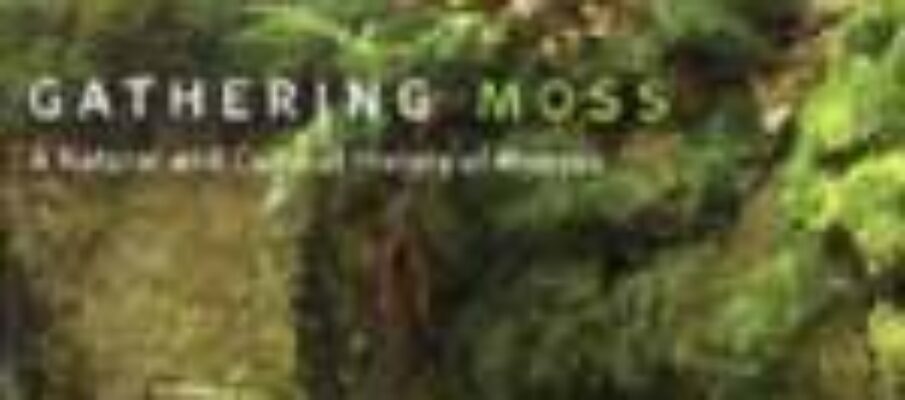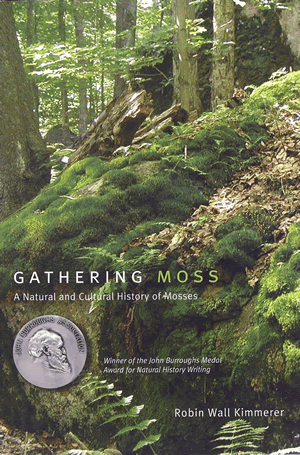Mosses – too small to be seen in detail without a strong hand lens and existing in a layer of atmosphere surrounding all terrestrial objects that is too subtle for our crude senses to perceive, they flourish throughout the world playing roles in the global ecosystem that we are only beginning to understand. By most people they are scarcely noticed at best; simply acknowledged as that fuzzy green stuff filling in sidewalk cracks and clinging to the bark of trees. At worst they are reckoned, often by home-owners, as the bane of house roof longevity and well-groomed lawns; something to be killed and removed whenever possible. Yet to those who would stop, even if only briefly to consider them, mosses are as fascinating as they are ancient. These last messages, along with a solid, introductory account of their natural history, are what Robin Wall Kimmerer seeks to convey to the reader in her book Gathering Moss: A Natural and Cultural History of Mosses. In this she succeeds marvelously in ways that are not only scientific but philosophical and poetic as well.
Drawing upon both her professional training as a bryologist (a botanist who specializes in the study of mosses, liverworts, and hornworts) as well as her ancestral heritage from the Potawatomi nation, Dr. Kimmerer, Associate Professor of Environmental and Forest Biology at the State University of New York College of Environmental Science and Forestry, interweaves the biological life histories of many different genera of mosses with recollections from both her own life and her native culture’s traditions.
Science demands that we understand a subject on our own terms; many Native American traditions urge us to understand all forms of life on their own terms. In Gathering Moss, Dr. Kimmerer successfully demonstrates that there is a place for both types of understanding that can and should be cultivated in seeking to understand not only mosses but everything in the natural world. In taking this approach to a subject – bryology – about which even many amateur naturalists know little if anything and of which the literature on the subject makes the study of seem dauntingly complex, Dr. Kimmerer brings the study of mosses gently to the interested reader and says “Look, feel, smell – this is moss. It is all around you. If you slow down and take the time to notice it, you will soon come to understand more than you ever knew you could. Here’s how it lives…”
In addition to presenting a splendidly accessible introduction to the natural history of mosses, as well as reflect upon her own personal as well as cultural experiences with them, she also presents the reader with a few interesting insights into some of the sadly less than admirable uses to which contemporary society has put mosses and the extremes to which some are willing to go in order to obtain them for these purposes – including one particular tale of landscape design in such colossal logistical and economic scales that it can best be described as surreal.
In the time since it was first released, Gathering Moss has gone through six printings. In 2005 Dr. Kimmerer was awarded the John Burroughs medal for writing it; a remarkably appropriate distinction as the book wonderfully reflects the Burroughs legacy of combining natural science with lyrical prose and philosophical inquiry to produce a work that not only enlightens the intellect of the reader but nourishes the soul as well.
Title: Gathering Moss: A Natural and Cultural History of Mosses
Author: Robin Wall Kimmerer
Publisher: Oregon State University Press
ISBN: 0-87071-499-6
Paperback, 168 pages
In accordance with Federal Trade Commission 16 CFR Part 255, it is disclosed that the copy of the book read in order to produce this review was bought personally by the reviewer.



Born Again Bird Watcher » Blog Archive » Well-read Naturalist: Gathering Moss
November 9, 2009 @ 14:43
[…] Wall Kimmerer’s Gathering Moss, an award-winning collection of essays both personal and bryological, is this week’s featured […]
Holiday Gift Book Suggestions at The Well-read Naturalist
December 18, 2009 @ 21:53
[…] Mosses – too small to be seen in detail without a strong hand lens and existing in a layer of atmosphere surrounding all terrestrial objects that is too subtle for our crude senses to perceive, they flourish throughout the world playing roles in the global ecosystem that we are only beginning to understand. By most people they are scarcely noticed at best; simply acknowledged as that fuzzy green stuff filling in sidewalk cracks and clinging to the bark of trees. At worst they are reckoned, often by home-owners, as the bane of house roof longevity and well-groomed lawns; something to be killed and removed whenever possible. Yet to those who would stop, even if only briefly to consider them, mosses are as fascinating as they are ancient. These last messages, along with a solid, introductory account of their natural history, are what Robin Wall Kimmerer seeks to convey to the reader in her book Gathering Moss: A Natural and Cultural History of Mosses. In this she succeeds marvelously in ways that are not only scientific but philosophical and poetic as well. (full review) […]
Holiday Gift Book Suggestions : John E. Riutta
April 21, 2010 @ 10:24
[…] Mosses – too small to be seen in detail without a strong hand lens and existing in a layer of atmosphere surrounding all terrestrial objects that is too subtle for our crude senses to perceive, they flourish throughout the world playing roles in the global ecosystem that we are only beginning to understand. By most people they are scarcely noticed at best; simply acknowledged as that fuzzy green stuff filling in sidewalk cracks and clinging to the bark of trees. At worst they are reckoned, often by home-owners, as the bane of house roof longevity and well-groomed lawns; something to be killed and removed whenever possible. Yet to those who would stop, even if only briefly to consider them, mosses are as fascinating as they are ancient. These last messages, along with a solid, introductory account of their natural history, are what Robin Wall Kimmerer seeks to convey to the reader in her book Gathering Moss: A Natural and Cultural History of Mosses. In this she succeeds marvelously in ways that are not only scientific but philosophical and poetic as well. (full review) […]
Two book recommendations for Naturalists, Biologists, and Teachers | Prairie Wo/anderings
November 18, 2012 @ 12:12
[…] Robin Kimmerer’s book “Gathering Moss, A Natural and Cultural History of Mosses” reveals what I’ve been missing by not taking Dr. Hall’s advice so long ago. This book is a revelation that despite their small stature, mosses and moss communities have a lot to teach us. Questions drive science and as a ecologist Kimmerer takes us along as she investigates moss community ecology. Most of her prose is dedicated to the questions and the journey with the discoveries and answers being almost an afterthought. I was amazed at the broader, more general ecological principles that she investigates through moss study. This book will not only engage you with mosses but it will help you develop a beginning understanding of some of the pressing ecological principles that drive the work of community ecologists today. One measure by which I judge a book like this is not on how many new facts and answers I learn but rather how many new insights and new questions do I now have. I find my self going back and re-reading her essays looking for inspiration and questions.By that measure this book is a winner. Check out this book, you won’t be disappointed. Here’s a nice review. […]
Two book recommendations for Naturalists, Biologists, and Teachers | KABT BioBlog
November 18, 2012 @ 12:13
[…] Robin Kimmerer’s book “Gathering Moss, A Natural and Cultural History of Mosses” reveals what I’ve been missing by not taking Dr. Hall’s advice so long ago. This book is a revelation that despite their small stature, mosses and moss communities have a lot to teach us. Questions drive science and as a ecologist Kimmerer takes us along as she investigates moss community ecology. Most of her prose is dedicated to the questions and the journey with the discoveries and answers being almost an afterthought. I was amazed at the broader, more general ecological principles that she investigates through moss study. This book will not only engage you with mosses but it will help you develop a beginning understanding of some of the pressing ecological principles that drive the work of community ecologists today. One measure by which I judge a book like this is not on how many new facts and answers I learn but rather how many new insights and new questions do I now have. I find my self going back and re-reading her essays looking for inspiration and questions.By that measure this book is a winner. Check out this book, you won’t be disappointed. Here’s a nice review. […]
Where forest meets sea (in which i rant on and on (and on) about Tahakopa Scenic Reserve) (and a lot of things really) | plant your excitement
May 5, 2015 @ 02:40
[…] a great book called Gathering Moss I’ve read it two times mom. It’s a very enjoyable read about mosses an’ that, […]
August 2016 | Lady Lit Book Club
January 30, 2017 @ 14:46
[…] “Science demands that we understand a subject on our own terms; many Native American traditions urge us to understand all forms of life on their own terms. In Gathering Moss, Dr. Kimmerer successfully demonstrates that there is a place for both types of understanding that can and should be cultivated in seeking to understand not only mosses but everything in the natural world.” :: Johannes E. Riutta […]